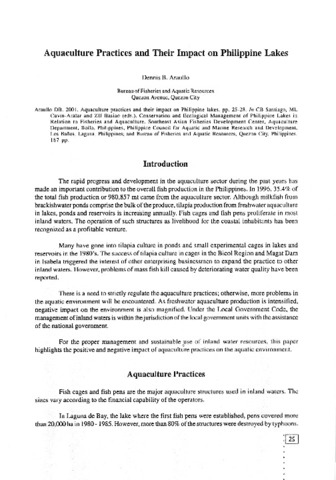Perlihatkan publikasi sederhana
The recreational value of Taal Volcano protected landscape: An exploratory benefit transfer application
| dc.contributor.author | Vista, Arvin B. | |
| dc.contributor.editor | Aralar, Maria Lourdes C. | |
| dc.contributor.editor | Borja, Adelina S. | |
| dc.contributor.editor | Palma, Adelaida L. | |
| dc.contributor.editor | Mendoza, Marlynn M. | |
| dc.contributor.editor | Ocampo, Pablo C. | |
| dc.contributor.editor | Manalili, Eduardo V. | |
| dc.contributor.editor | Darvin, Loureeda C. | |
| dc.coverage.spatial | Taal, Lake | en |
| dc.coverage.spatial | Volcano Island | en |
| dc.coverage.spatial | Batangas | en |
| dc.coverage.spatial | Philippines | en |
| dc.date.accessioned | 2020-06-17T07:25:44Z | |
| dc.date.available | 2020-06-17T07:25:44Z | |
| dc.date.issued | 2013 | |
| dc.identifier.citation | Vista, A. B. (2013). The recreational value of Taal Volcano protected landscape: An exploratory benefit transfer application. In M. L. C. Aralar, A. S. Borja, A. L. Palma, M. M. Mendoza, P. C. Ocampo, E. V. Manalili, & L. C. Darvin (Eds.), LakeCon2011: Building on the pillars of Integrated Lake Basin Management (Second National Congress on Philippine Lakes) (pp. 151-168). Los Baños, Laguna, Philippines: PCAARRD-DOST. | en |
| dc.identifier.issn | 1656-8099 | |
| dc.identifier.uri | http://hdl.handle.net/10862/5851 | |
| dc.description.abstract | Some landscapes that have significant value to people are protected through statute. Protected landscapes that serve as popular recreational resources and destinations hold significant use values for the people that visit them. Recognition of these recreational benefits of protected landscapes provides a sound economic rationale for their management. This paper provides estimates of the potential magnitude of recreational value via benefit transfers of Taal Volcano Protected Landscape in the Philippines - a major tourist attraction and designated as one of the key priority biodiversity areas for protection. Taal Volcano Protected Landscape is a popular area for recreation activities such as hiking, day-camping, picnicking, bird watching, horseback riding, fishing, boating, wind surfing, sailing, rowing, and kayaking. Benefit transfer is the use of information from research conducted on other sites (i.e., the study sites) to pose questions at a site (i.e., Taal Volcano Protected Landscape, the policy site) that lacks primary research. Benefit transfer approaches include: 1) transferring of values or functions from a single site or set of similar sites, and 2) estimating a meta-regression transfer function that can be used to predict values for the policy site in question. One study site in the Philippines was selected and used in a point estimate transfer application. Likewise, a meta-regression transfer function model was estimated based on selected study sites from the US. These study sites were selected based on their similarity in terms of recreation activity, climate, and/or site characteristics with that of the Taal Volcano Protected Landscape. Furthermore, implicit price deflators and purchasing power parity are incorporated to account for income and cost of living differences between the study and policy sites. Exogenous factors, such as differences in individual preferences, cultural, and institutional conditions between the Philippines and the United States are beyond the scope of this paper, but these have the potential to invalidate the result of an international benefit transfer. Results show that point estimate transfer approach provided a better estimate of access value than meta-regression benefit function transfer approach. While in-sample benefit transfer predictions of the metaregression model show an absolute percentage transfer error of 18%, the simple out-of-sample prediction result has very high absolute percentage transfer error (1,231%). Hence, in policy application, a model with more than 100% transfer error is not suggested. The estimated welfare estimate of recreational access using point estimate transfer was P36/person per trip in 2006. The aggregated recreational benefits at the Taal Volcano Protected Landscape in 2006 was P9.7 million from 155,701 visitors at the Batangas side and P118.9 million from 1,906,242 visitors at the Cavite side, for a sum of about P128 million. This access value is not equivalent to economic resources that can be generated when visitor use fees is imposed to the users. User fees should be based on a willingness-to-pay (WTP) study that captures public perceptions and WTP fees, among others. | en |
| dc.language.iso | en | en |
| dc.publisher | PCAARRD-DOST | en |
| dc.relation.ispartofseries | Summary of Proceedings No. 1/2013; | |
| dc.subject | Chanos chanos | en |
| dc.subject | Caranx ignobilis | en |
| dc.title | The recreational value of Taal Volcano protected landscape: An exploratory benefit transfer application | en |
| dc.type | Conference paper | en |
| dc.citation.spage | 151 | |
| dc.citation.epage | 168 | |
| dc.citation.conferenceTitle | LakeCon2011: Building on the pillars of Integrated Lake Basin Management (Second National Congress on Philippine Lakes) | en |
| dc.subject.asfa | volcanoes | en |
| dc.subject.asfa | recreation | en |
| dc.subject.asfa | protected areas | en |
| dc.subject.asfa | tourism | en |
| dc.subject.asfa | water quality | en |
| dc.subject.asfa | ecology | en |
| dc.subject.asfa | lakes | en |
| dc.subject.asfa | fish culture | en |
| dc.subject.asfa | cages | en |
| dc.subject.asfa | lake fisheries | en |
| dc.subject.asfa | analysis | en |
| dc.subject.asfa | regression analysis | en |
| dc.subject.scientificName | Hydrophis semperi | en |
| dc.subject.scientificName | Chanos chanos | |
| dc.subject.scientificName | Sardinella tawilis | en |
| dc.subject.scientificName | Sarotherodon niloticus | en |
Files in this item
| Files | Size | Format | View |
|---|---|---|---|
|
There are no files associated with this item. |
|||
Publikasi ini ada di koleksi berikut
-
LakeCon2011 [30]
2nd National Congress on Philippine Lakes




